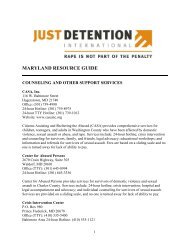STOP PRISONER RAPE - National Center on Domestic and Sexual ...
STOP PRISONER RAPE - National Center on Domestic and Sexual ...
STOP PRISONER RAPE - National Center on Domestic and Sexual ...
Create successful ePaper yourself
Turn your PDF publications into a flip-book with our unique Google optimized e-Paper software.
III. SYSTEMIC CONDITIONS GIVING RISE TO SEXUAL ASSAULT IN DETENTION“How was it possible, in a protective custody unit, for twogang members who had spent many years in pris<strong>on</strong> to rapea vulnerable man who had never been to pris<strong>on</strong> <strong>and</strong> nevercommitted a violent crime? At the time of the rape, a singleofficer was resp<strong>on</strong>sible for observing a day room, a diningarea, <strong>and</strong> two floors of cells with open doors. It was notpossible, at any given time, for that officer to observe the entireunit. [T]he victim [reported] that the rape took place over aforty-five minute time span, in a sec<strong>on</strong>d floor cell, while theofficer was in the day room, where she was unable to see insidethe cells <strong>on</strong> the sec<strong>on</strong>d floor…But in an overcrowded system,it is unlikely that pris<strong>on</strong>ers of different security levels who areidentified as being in need of protective custody will be furthersegregated…”Terry Kupers, “Rape <strong>and</strong> the Pris<strong>on</strong> Code,” in Pris<strong>on</strong> Masculinities 113 (D<strong>on</strong> Saboet. al. eds., 2001).As the U.S. inmate populati<strong>on</strong> c<strong>on</strong>tinuesto swell, the likelihood of sexual abuseincreases. Pris<strong>on</strong> <strong>and</strong> jail administratorsacross the nati<strong>on</strong> are failing to keeptheir populati<strong>on</strong>s from outpacing thecapacity of existing facilities. Partly dueto the massive influx of new inmates,many pris<strong>on</strong>s <strong>and</strong> jails also fail to ensurethat n<strong>on</strong>-violent, first-time offenders areseparated from potentially predatoryinmates. In additi<strong>on</strong>, a ‘code of silence’that is h<strong>on</strong>ored by pris<strong>on</strong>ers <strong>and</strong>correcti<strong>on</strong>s officials alike c<strong>on</strong>tinues tokeep pris<strong>on</strong>er rape shrouded in secrecyboth inside pris<strong>on</strong>s <strong>and</strong> jails <strong>and</strong> insociety at large.A. Over-Incarcerati<strong>on</strong> <strong>and</strong> Pris<strong>on</strong> OvercrowdingWith more than 2.2 milli<strong>on</strong> people behind bars, theU.S. incarcerates a larger percentage of its populati<strong>on</strong>than any other country in the world. The inmatepopulati<strong>on</strong> quadrupled between 1980 <strong>and</strong> 1999. 15More than 500,000 of these pris<strong>on</strong>ers are incarcerated<strong>on</strong> drug charges. 16Although public support in the U.S. for the “war <strong>on</strong>drugs” has waned c<strong>on</strong>siderably in recent years, the U.S.government has c<strong>on</strong>tinued to pursue anti-drug policiesthat lead to the incarcerati<strong>on</strong> of large numbers of low-leveldrug users. Exceedingly l<strong>on</strong>g drug sentences c<strong>on</strong>tributeto the current pris<strong>on</strong> overcrowding <strong>and</strong> understaffing.Despite a pris<strong>on</strong> building boom of nearly two decades,officials at many U.S. correcti<strong>on</strong>s facilities have had toc<strong>on</strong>vert cafeterias <strong>and</strong> gymnasiums into dormitories. Suchsevere overcrowding creates opportunities for predators, 17as procedures for housing potential perpetrators <strong>and</strong>victims of sexual violence separately tend to be overlookedin facilities with a shortage of beds. 18“Teresa Smith,” a mother of two <strong>and</strong> a victimof sexual abuse during childhood, began to usepowdered cocaine at age 19 <strong>and</strong> eventuallybecame addicted to crack cocaine. She wassent to pris<strong>on</strong> for the first time at age 26 forpossessi<strong>on</strong> of stolen goods, <strong>and</strong> was in <strong>and</strong> outof pris<strong>on</strong> for the next 11 years. Smith wasraped by correcti<strong>on</strong>s officials twice, <strong>and</strong> wasrepeatedly sexually harassed <strong>and</strong> assaultedthroughout her years in pris<strong>on</strong>. She told SPR:“The pris<strong>on</strong>s are so overcrowded, <strong>and</strong> theofficers take advantage of that. They see allyour weaknesses. Some of them are predators.The gym is where I slept in <strong>and</strong> there were 120women in there. There is no privacy. Thereare no partiti<strong>on</strong>s. There are no doors…. Whathappens when you kick the covers off in bed atnight? You have got officers walking by withflashlights looking at you. Being locked upin that kind of envir<strong>on</strong>ment was devastating– emoti<strong>on</strong>ally, physically, <strong>and</strong> mentallydraining.”SPR staff in-pers<strong>on</strong> interview, August 2005.8IN THE SHADOWS: <strong>Sexual</strong> Violence in U.S. Detenti<strong>on</strong> Facilities





